Electronic BulbWhat is an Electronic Bulb?Before the introduction of the electric bulb, people used to depend on candles and oil lamps for lighting. These tools of artificial lighting were not very feasible and had extreme limitations. Candles were compact but had a very limited usage time and the light emitted was not the brightest. Other methods such as Gas lighting or Electric arc lighting (which worked by creating an electric arc between two carbon electrodes, which produced a bright, white light) were very resource intensive and the apparatus required for their successful usage was very complex. This changed in 1879 when Thomas Edison publicly demonstrated his incandescent light bulb by illuminating a street in Menlo Park, New Jersey. What is an Electronic Bulb?An electric bulb, also called an incandescent light bulb or incandescent lamp is a device that produces light by passing an electric current through a wire-like object called a filament, which then becomes hot and emits visible light. This filament is placed in a glass with a vacuum or some inert gas to prevent it from oxidizing or burning down. 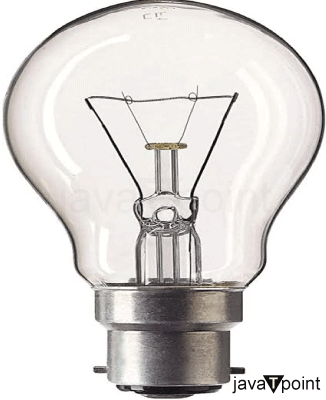
Structure of a Light Bulb:The most significant parts of a light bulb are:
Starting with the filament, it can be said to be the central part of a light bulb. The filament is a coiled wire which when provided with electric current glows up and emits visible light. Filaments are usually made of Tungsten that is because tungsten has a high melting point meaning it can survive high temperatures without melting or breaking. The filament is enclosed in a glass envelope or glass bulb. This glass envelope is designed to protect the filament from oxidation and to provide thermal insulation. The glass envelope is usually made of silica or borosilicate glass, which can withstand the high temperatures generated by the filament. The glass used can be clear or coated. The coated glass contains kaolin clay which is used to alter or adjust the intensity of the light. To obtain coloration, coatings of dopants like chromium are used. For bulbs used as heating elements, which often reach a temperature of around 250 �C or higher, quartz glass is used. The purpose of this glass envelope is to prevent the filament from getting damaged as well as keep the air out to prevent oxidation of the filament and the burning of the filament when a current is passed. The next major component of the bulb is the cap or the base of the bulb. The base of an electric bulb is the part that connects to the socket and provides the electrical contact for the bulb. The base is typically made of metal. These metals range from aluminum to brass, characteristically speaking metals that are durable and conduct electricity fairly easily. The selection of these metals however boils down to factors such as cost and compatibility. There are multiple types of bases or caps, the most common being the Edison screw base, the pin base or the contact base.
Apart from these three main components, there are a few other crucial elements that constitute the working of an electric bulb. The most prominent one is the inert gasses filled in the glass envelope. Even though traditionally the incandescent or the electric bulb was supposed to be filled with vacuum, they often contain inert gasses. The reason is that these gasses slow down the oxidation of the filament as well as prevent the evaporation of the said filament. The gasses that are mostly used are Argon (Ar) and Nitrogen (N2). The gasses that are filled in the envelope must be chosen with great care to prevent the transfer of heat through the gas. Other than Argon and Nitrogen, other gasses such as Helium, Neon and Krypton are also used. Helium is used because it has good thermal conductivity and helps the filament from heating up excessively, however, bulbs containing Helium tend to be costlier than vacuum bulbs or bulbs with Argon and Nitrogen. Neon is used for decorative purposes thanks to its tendency to glow bright red when excited with electricity. Krypton being another noble gas is suitable to be used in bulbs. Krypton shines a bright white color when excited by electric current, therefore Krypton is used in bulbs to increase their luminosity. Another part of the bulb is the Stem. The stem is the structure that connects the base of the bulb to the glass envelope containing the filament. Traditional incandescent bulbs do not typically have a distinct stem. Stems might be used merely for decorative purposes but it does help in securing the position of the filament in the glass envelope. This is important because the filament is very delicate and it can easily break if it is not supported properly. It also provides electrical connections to the filament. History of the Electric Bulb:Decades before Edison presented the first functioning electric bulb, the concept of electric lighting existed. In 1802, Humphry Davy, an English chemist, invented the first electric arc lamp. An electric arc lamp consisted of two electrodes with a carbon rod in the middle. When supplied with electricity this rod would heat up and glow. The problem with the electric arc lamp was that the rod would burn up almost instantly and the light produced was too bright to be applicable in any practical method. Despite not being a success, the electric arc lamp proved that producing light with electricity was possible. The next major breakthrough came in 1840 when the English physicist, Warren de la Rue, invented the first incandescent light bulb. In this light bulb, he used a platinum filament encased in a glass bulb, filled with vacuum. This platinum filament would provide a bright light when provided with electricity. The problem with this model was that the platinum would burn up quickly and was very expensive. Taking account of this model, Edison and his team began serious research into the metals and materials that could be used to make the filament. This research with different designs, spanned across the period of years. The breakthrough came in 1879 when Edison used a carbonized filament of uncoated cotton thread. Before this, he had been using Carbon but then he switched to Platinum-based filament but eventually returned to the Carbon filament. Using the carbonized cotton thread, Edison and his team managed to extend the life of the filament to nearly 15-16 hours. This was surpassed by a filament made of bamboo, which would last up to Thousands of hours. Finally, in 1890, the filament in Edison's bulb was replaced with Tungsten filament which proved to be much more tolerant of high temperature and hence provided a longer lifetime. 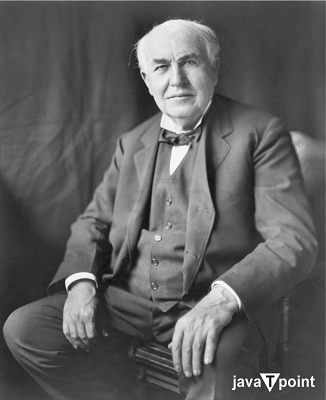
The invention of the light bulb or the electric bulb was no small feat as it changed the behavior of society. With these bulbs, light of higher intensity could be provided, the bulbs were feasible. The introduction of these bulbs increased the work hours into the evening and night, made it easier to travel in the night time and gave way for numerous businesses to be built. Even though Edison is highly regarded for his commercial success with the light bulb, it must be noted that his work and design were based upon the work of numerous other inventors and scientists. Notable figures include Humphry Davy, Warren de la Rue, and Joseph Swan. Uses of Electric Bulbs:The success of Electric bulbs meant it could be used commercially and domestically.
Later on, electric bulbs were put to more practical uses such as headlights for vehicles. They were used to make hand-held torches. Advantages of Electric Bulbs:The electric or incandescent bulbs had a complete win over the more conventional methods of lighting such as electric arc lamps and oil lamps. Some of them are:
Disadvantages of Electric Bulbs:Even though electric bulbs revolutionized the lighting capabilities of modern society, it did not come with their own drawbacks. These drawbacks were only highlighted as the methods of producing electric light evolved.
Shift towards Energy Efficiency:The low energy efficiency of incandescent bulbs turned out to be a major problem, especially for commercial purposes where a large number of these bulbs were used. The introduction of newer technology led to the phasing out of incandescent bulbs. 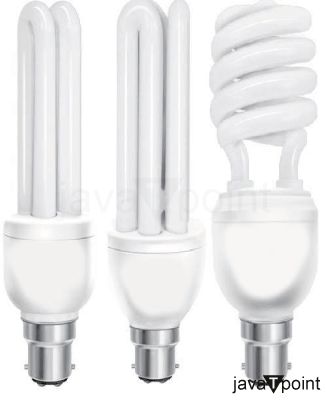
The first major transition was brought by Compact Fluorescent Lamps or CFLs. The CFL contains mercury vapors, which when ionized by the arcing caused by the two electrodes present in the lamp, produce UV light. This UV passes through the glass tube coated with a phosphor material, which converts this UV light to visible light. CFLs had a much higher energy efficiency than incandescent bulbs. 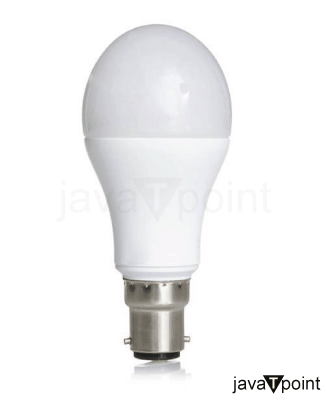
The most efficient option, however, was LED or Light-emitting Diode lamps. By far, LED is the most power-efficient option. LED lamps produce light through the process of electroluminescence. When an electric current passes through a semiconductor material within the LED, it emits light. The specific materials used in the semiconductor determine the color of the emitted light. The high energy efficiency of the LED is due to minimal energy leaks due to heat generation. In comparison to traditional bulbs, LEDs are 75% more energy efficient. LED lamps have a significantly longer lifespan compared to traditional bulbs. They can last tens of thousands of hours, which translates to several years of usage under normal conditions. The extended lifespan reduces the need for frequent replacements, contributing to cost savings and convenience. The LED lights also come in a wide range of colors which makes them more suitable for decorations and advertising. Since LEDs are diodes made up of semiconductors, they use little electrical energy and their output power can be easily controlled and altered by altering the supply of electric current. This makes LEDs way more versatile than Incandescent bulbs. Due to this versatile behavior of LEDs, they have a wide practical use such as TV screens and mobile screens. Conclusion:The commercial success of the Incandescent bulb, thanks to Edison, permanently changed human society for the better. The highly convenient method of lighting made not only living and venturing in the dark easier but also elongated the working hours into the nighttime. 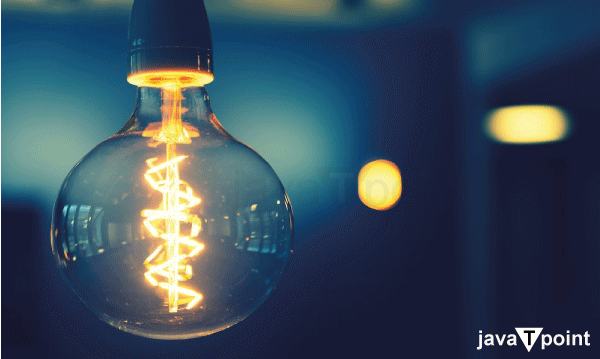
In today's world traditional Incandescent bulbs are being phased out due to their inefficiency and being replaced by more cost and environment-friendly LED lamps. Governments all around the world have taken measures to introduce LED lamps not just into the commercial world but also the households. Traditional Incandescent bulbs are rarely used practically anymore, they are just reduced to decorations or are used for aesthetic purposes in cafes and restaurants because of the dim and warm light that they produce.
Next TopicCircular Motion
|
 For Videos Join Our Youtube Channel: Join Now
For Videos Join Our Youtube Channel: Join Now
Feedback
- Send your Feedback to [email protected]
Help Others, Please Share









